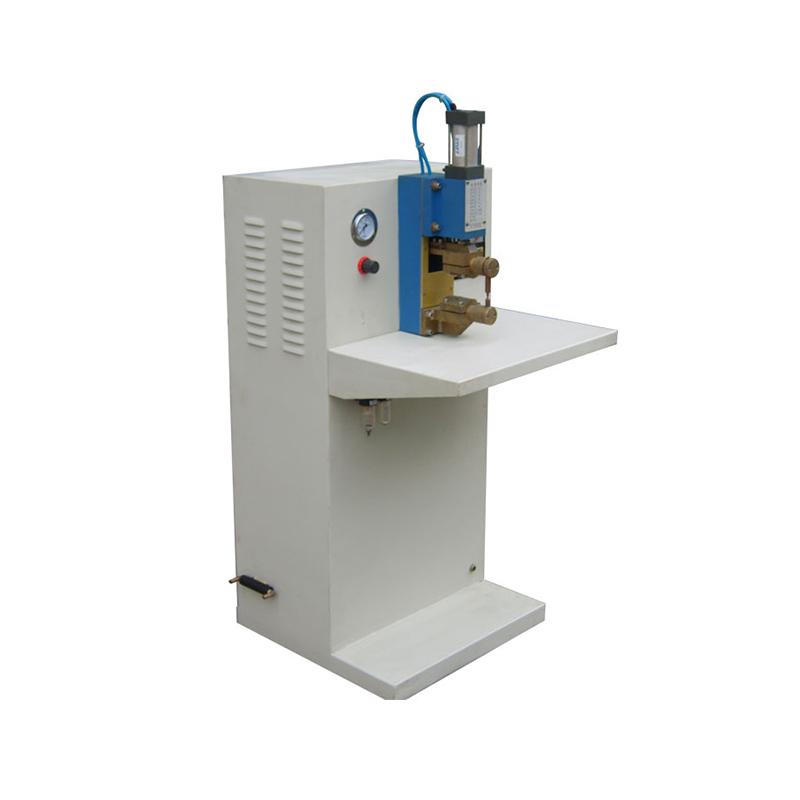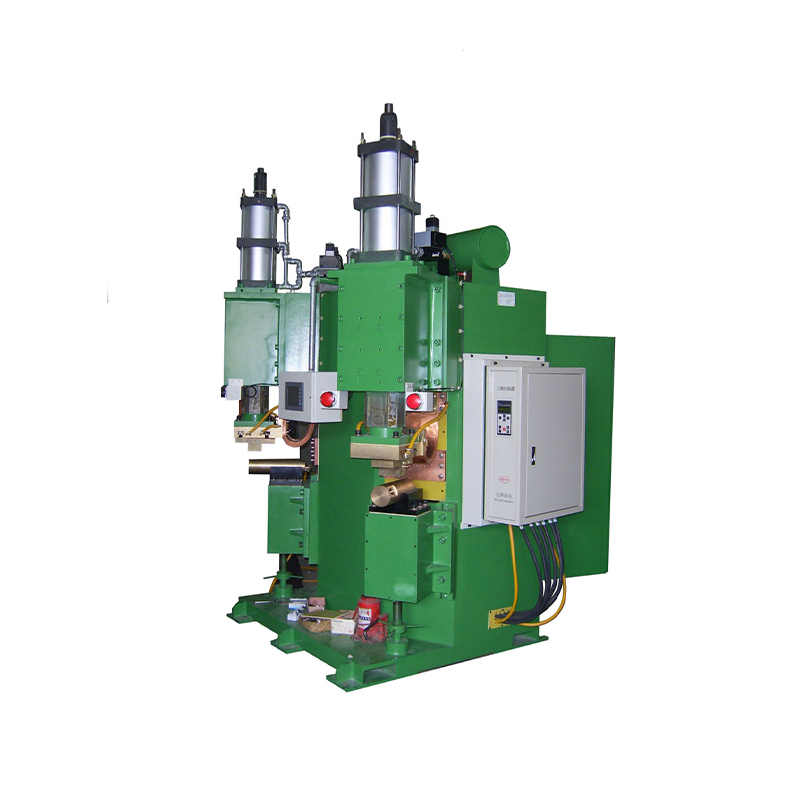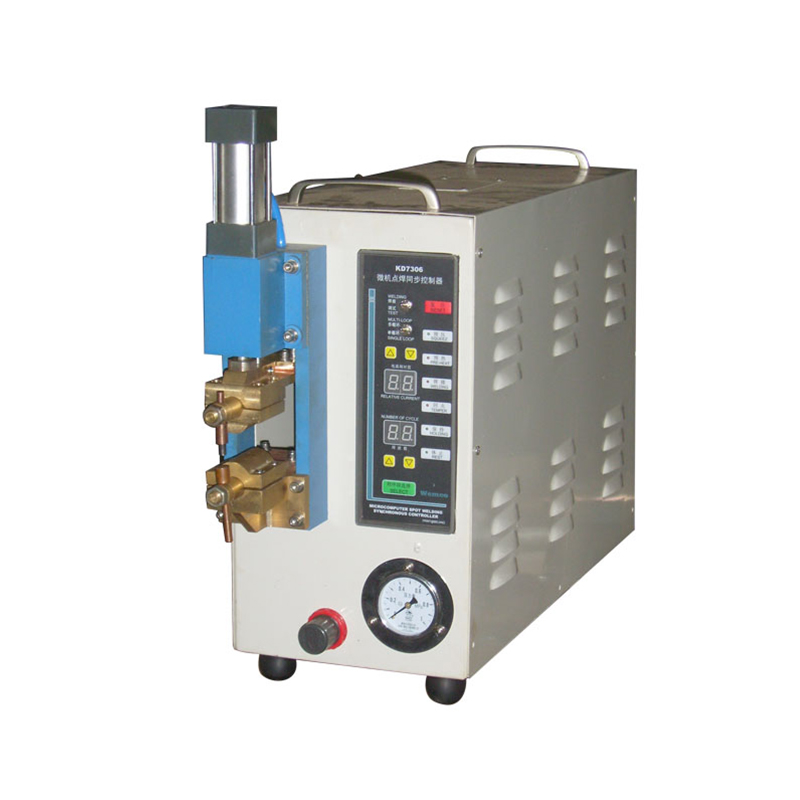Where does the three-phase secondary rectifier double-head welding machine's process stability come from?
Release Time : 2025-10-08
In modern industrial manufacturing, welding requires both efficiency and quality. The three-phase secondary rectifier double-head welding machine not only operates two welding stations simultaneously, but also maintains consistent welds, minimal spatter, and controllable weld depth even during long, high-load operations.
1. Three-Phase Power Supply: Laying the Foundation for Stable Current
Compared to single-phase welding machines, the three-phase secondary rectifier double-head welding machine utilizes an industrial three-phase 380V power supply. Three AC lines, each 120 degrees out of phase, provide a shared power supply, significantly reducing input power fluctuations. This power supply fundamentally eliminates the alternating current "valleys" and "peaks" common in single-phase systems, providing nearly constant energy input during the welding process. Especially when two welding heads are operating simultaneously, the three-phase power supply evenly distributes the load, avoiding voltage drops or grid interference caused by transient high current surges. This ensures synchronized and stable welding of the two arcs, laying a solid foundation for high-quality welds.
2. Secondary Rectification: Achieving Pure and Precise DC Output
Secondary rectification is the core technology underlying this welder's stability. Traditional AC welders directly utilize the transformer's secondary AC output. This makes the arc susceptible to current zero crossings, causing frequent extinguishing and re-ignition, resulting in large spatter and shallow weld penetration. Three-phase secondary rectification welders, on the other hand, perform full-wave rectification on the transformer's secondary side, converting the AC power into a DC output with minimal pulsation. This DC arc eliminates zero crossings, resulting in continuous, concentrated combustion and uniform heat distribution. This significantly reduces metal spatter and achieves deeper weld penetration and a narrower heat-affected zone. More importantly, the rectified current responds quickly. Combined with a closed-loop control system, this allows for millisecond-level dynamic adjustment of welding parameters. Even with variations in the plate gap or electrode wear, it automatically compensates for these changes, maintaining process consistency.
3. Dual-Head Collaboration: Optimizing Structure and Control
As a dual-head device, its stability lies not only in its single-channel performance but also in the collaborative reliability of its dual workstations. Three-phase secondary rectifier double-head welding machines typically utilize a transformer design with a shared core and independent windings, ensuring electrical isolation and energy sharing between the two outputs to prevent mutual interference. Furthermore, the control system independently sets and monitors parameters such as current, voltage, and timing for the two welding guns in real time, supporting both synchronous and asynchronous welding modes. On automated production lines, this design allows for alternating workstations, improving equipment utilization. In manual operation, it ensures that the two welders do not interfere with each other, doubling efficiency. Furthermore, the machine utilizes high-permeability silicon steel sheets and low-resistance copper windings, coupled with forced air or water cooling. Even in a 40°C workshop with continuous operation for over eight hours, the temperature rise remains within a safe range, preventing performance degradation due to overheating.
4. Process Adaptability: Stability stems from a deep understanding of the application scenario.
True stability is ultimately reflected in weld quality. The three-phase secondary rectifier double-head welding machine is widely used for spot, seam, and projection welding of materials such as mild steel, galvanized sheet, and stainless steel. Its output characteristics precisely match the resistance and thermal requirements of different materials. For example, in automotive body-in-white welding, it maintains a ±3% current repeatability, ensuring consistent strength across thousands of welds. In steel bridge construction, it also easily handles the high energy density and low spatter characteristics required for thick plate welding. This "stability" isn't just laboratory data; it's proven through rigorous testing on the production line.
In summary, the process stability of the three-phase secondary rectifier double-head welding machine stems from the balanced power supply of the three-phase power supply, the pure DC output of the secondary rectifier, the coordinated control of the dual-head system, and its deep adaptability to industrial scenarios. It's more than just welding equipment; it's a guardian of manufacturing precision and reliability. In modern manufacturing, which strives for high quality, high efficiency, and minimal rework, this "double-head warrior" silently and resolutely welds every seam that matters to safety and quality.
1. Three-Phase Power Supply: Laying the Foundation for Stable Current
Compared to single-phase welding machines, the three-phase secondary rectifier double-head welding machine utilizes an industrial three-phase 380V power supply. Three AC lines, each 120 degrees out of phase, provide a shared power supply, significantly reducing input power fluctuations. This power supply fundamentally eliminates the alternating current "valleys" and "peaks" common in single-phase systems, providing nearly constant energy input during the welding process. Especially when two welding heads are operating simultaneously, the three-phase power supply evenly distributes the load, avoiding voltage drops or grid interference caused by transient high current surges. This ensures synchronized and stable welding of the two arcs, laying a solid foundation for high-quality welds.
2. Secondary Rectification: Achieving Pure and Precise DC Output
Secondary rectification is the core technology underlying this welder's stability. Traditional AC welders directly utilize the transformer's secondary AC output. This makes the arc susceptible to current zero crossings, causing frequent extinguishing and re-ignition, resulting in large spatter and shallow weld penetration. Three-phase secondary rectification welders, on the other hand, perform full-wave rectification on the transformer's secondary side, converting the AC power into a DC output with minimal pulsation. This DC arc eliminates zero crossings, resulting in continuous, concentrated combustion and uniform heat distribution. This significantly reduces metal spatter and achieves deeper weld penetration and a narrower heat-affected zone. More importantly, the rectified current responds quickly. Combined with a closed-loop control system, this allows for millisecond-level dynamic adjustment of welding parameters. Even with variations in the plate gap or electrode wear, it automatically compensates for these changes, maintaining process consistency.
3. Dual-Head Collaboration: Optimizing Structure and Control
As a dual-head device, its stability lies not only in its single-channel performance but also in the collaborative reliability of its dual workstations. Three-phase secondary rectifier double-head welding machines typically utilize a transformer design with a shared core and independent windings, ensuring electrical isolation and energy sharing between the two outputs to prevent mutual interference. Furthermore, the control system independently sets and monitors parameters such as current, voltage, and timing for the two welding guns in real time, supporting both synchronous and asynchronous welding modes. On automated production lines, this design allows for alternating workstations, improving equipment utilization. In manual operation, it ensures that the two welders do not interfere with each other, doubling efficiency. Furthermore, the machine utilizes high-permeability silicon steel sheets and low-resistance copper windings, coupled with forced air or water cooling. Even in a 40°C workshop with continuous operation for over eight hours, the temperature rise remains within a safe range, preventing performance degradation due to overheating.
4. Process Adaptability: Stability stems from a deep understanding of the application scenario.
True stability is ultimately reflected in weld quality. The three-phase secondary rectifier double-head welding machine is widely used for spot, seam, and projection welding of materials such as mild steel, galvanized sheet, and stainless steel. Its output characteristics precisely match the resistance and thermal requirements of different materials. For example, in automotive body-in-white welding, it maintains a ±3% current repeatability, ensuring consistent strength across thousands of welds. In steel bridge construction, it also easily handles the high energy density and low spatter characteristics required for thick plate welding. This "stability" isn't just laboratory data; it's proven through rigorous testing on the production line.
In summary, the process stability of the three-phase secondary rectifier double-head welding machine stems from the balanced power supply of the three-phase power supply, the pure DC output of the secondary rectifier, the coordinated control of the dual-head system, and its deep adaptability to industrial scenarios. It's more than just welding equipment; it's a guardian of manufacturing precision and reliability. In modern manufacturing, which strives for high quality, high efficiency, and minimal rework, this "double-head warrior" silently and resolutely welds every seam that matters to safety and quality.







